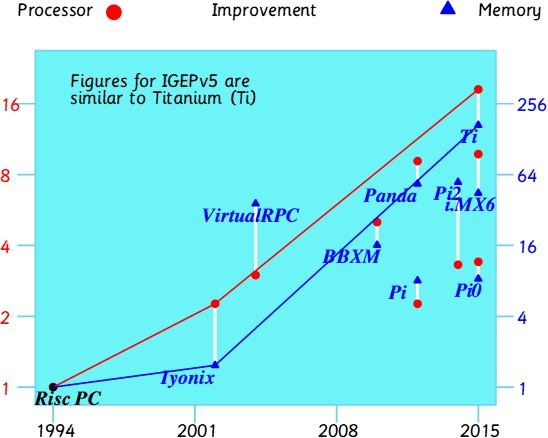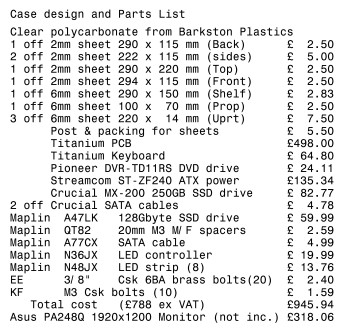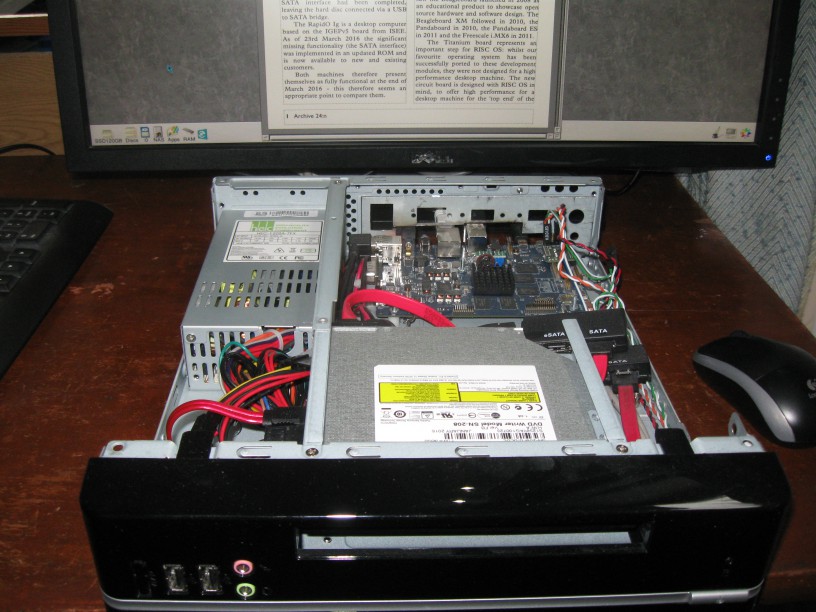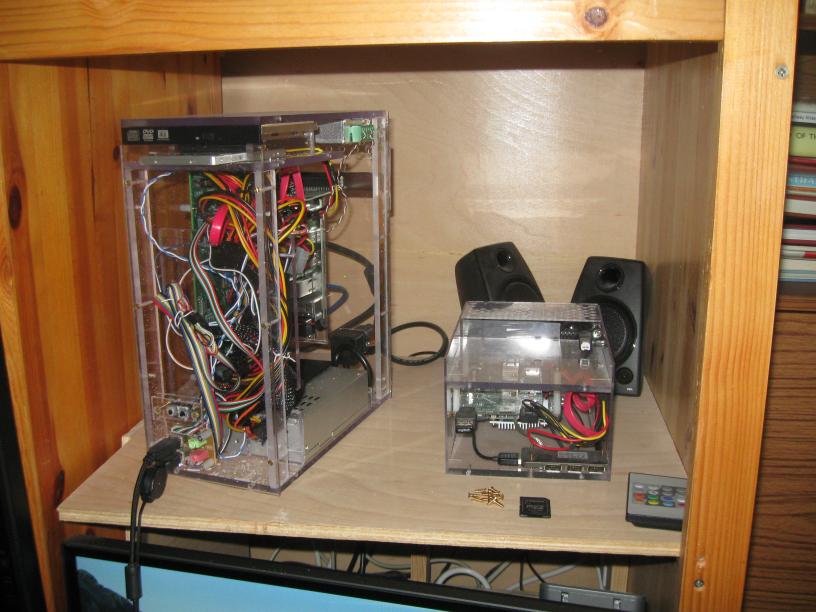Which machine do I buy? An impossible comparison
Elesar Ltd announced their new motherboard, christened 'Titanium', at the London show on 24th October 2015. It was demonstrated on the ROOL stand, appeared fully functional, including a SATA-connected solid state disc controlled by ADFS, a new module by Piccolo Systems, proudly demonstrated by Ben Avison. It was available for sale from 7 December 2015.
The Titanium is a wholly new Cortex-A15 motherboard designed with RISC OS in mind. As of 26th March 2016 the minor teething troubles have been eradicated in a revised ROM ('RC3'), available from the ROOL download page (which contains both a high vector (ZPP) and a low vector (non-ZPP) version of the ROM).
CJE Micros announced their new computer, now named the 'RapidO Ig', at the Wakefield show in April 2015. It was demonstrated on the CJE stand but there were some aspects that were, at that time, not complete. It was on sale there to 'early adopters' (and I bought one). It was formally released at the London show in October 2015 - by which time all but the SATA interface had been completed, leaving the hard disc connected via a USB to SATA bridge.
The RapidO Ig is a desktop computer based on the IGEPv5 board from ISEE. As of 23rd March 2016 the significant missing functionality (the SATA interface) was implemented in an updated ROM and is now available to new and existing customers.
Both machines therefore present themselves as fully functional at the end of March 2016 - this therefore seems an appropriate point to compare them.
Speed comparison
Benchmarks can be misleading, so here's a very rough comparison:

The processor and motherboard
Motherboard development is probably worth some discussion: the Pandaboard ES was released some time ago, based on the Texas Instruments OMAP4 platform - a Cortex-A9 processor. Development continued and there had been much anticipation of a newer board based on the OMAP5 platform which would feature a Cortex-A15 processor. Unfortunately TI cancelled the Pandaboard5 (and moved to the Sitara platform which had been developing in parallel as the AM335x and then the AM572x) but the OMAP5432 chip that it would have used (a logical development of the previous Texas Instruments OMAP3 (Beagleboard) and OMAP4 (Pandaboard) processors) has been included on the IGEPv5 Evaluation Module from ISEE at a cost of about £250.
A development module for the OMAP5 (IGEPv5) exists and one for the AM5728 (Beagleboard-X15) is expected in May 2016 (but has already been delayed several times). These follow the 'low cost' development module design that saw the Beagleboard launched in 2008 as an educational product to showcase open source hardware and software design. The Beagleboard XM followed in 2010, the Pandaboard in 2010, the Pandaboard ES in 2011 and the Freescale i.MX6 in 2014.
The Titanium board represents an important step for RISC OS: whilst our favourite operating system has been successfully ported to these development modules, they were not designed for a high performance desktop machine. The new circuit board is designed with RISC OS in mind, to offer high performance for a desktop machine for the 'top end' of the RISC OS market.
It is therefore as important a step as was the release of the Archimedes computer in 1987, the Risc PC in 1994, the Iyonix computer in 2002, Virtual Risc PC in 2004, the HAL-based RISC OS for the Beagleboard in 2010, RISC OS and SDFS for the Raspberry Pi in 2012 and the i.MX6 in 2015.
The Titanium circuit board utilises the Texas Instruments AM5728 Sitara processor 'built to meet the intense processing needs of the modern embedded products and combine programmable video processing with a highly integrated peripheral set'. The Titanium motherboard is thus rather different from the development boards mentioned - it has been designed as a desktop computer motherboard and thus offers more ports and expansion capability.
Hardware comparison
The first step is to compare the hardware (i.e. the motherboard). Both machines offer a dual core Cortex-A15 processor running at 1500MHz with similar additional cores for acceleration. Whilst the IGEPv5 offers 4GB of RAM and the Titanium offers 2GB (actually 2050.5MB), both are of similar speed offering around 8GB/s potential maximum transfer speed memory to memory. RISC OS cannot currently handle much more than 2GB, though some preparatory work has already been done. It will be interesting to see what uses users find for 2 or 4GB of RAM.
Both machines have on-board 'flash' memory and a micro SD card, gigabit Ethernet, SATA connector, real time clock, serial port, USB sockets etc. For those wanting the 'D-I-Y' solution, the bare board is available with a fully licensed copy of RISC OS provided. The Titanium ROM is available from the ROOL site.
I understand that the IGEPv5 sources and built ROMs should appear shortly on the ROOL site but this will not include the IGEPv5 specific part of the SATA driver which CJE commissioned. CJE plan on providing both ZPP and non-ZPP SATA enabled ROMS.
Users of 'bare board' IGEPv5's bought from ISEE (£250) can buy from CJE licensed SATA-enabled IGEPv5 ROMs and will receive updates direct from CJE whilst the two year exclusive licence is in force.
The cost of the 'home-made' Titanium is broken down as follows:

The total cost of the 'home-made' Titanium computer is made up as shown above. The LED display is not entirely decorative - the Titanium draws so little power (particularly from the 12V line) that some ATX power supplies will turn themselves off. Here was an excuse to add some RGB LEDs to the 12V line and make the theme for my computer 'Project Orac'.
ZPP or non-ZPP?
Developers need ZPP high vector ROMs so that software testing can proceed. Most users will need to run Aemulor to support older software and current builds of Impression-X. Aemulor will only run on low vector (non-ZPP) rom builds. The SATA driver is a paid-for upgrade and so four versions of the ROM will need to be provided for the Rapido (SATA and non-SATA and ZPP and non-ZPP).
Choices, choices
Faced with such a rich choice - three relatively new desktop machines with a difficult balance between price and performance - we now have the opportunity to replace our ageing Iyonix or Risc PC hardware.
My comparison of how the machines feel to the user is based on a comparison between the machines I possess. The RapidO Ig was supplied in a HEC 8K01 Mini-ITX case with internal power supply and drive bay containing a DVD writer (USB connected via a USB/SATA bridge):

The RapidO Ig with the lid removed showing the circuit board. It is running Aemulor 2.35 (IGEP) and Impression-X 5.77 at 1920x1200 (1920x1080 doesn't seem to work with this monitor, a Dell P2310Hc)
The Titanium was supplied as a bare board and I also bought the rear shield pressing but provided the case and other components myself:

The two 'home-made' machines - Titanium on the left with two SSD drives and a DVD and the i.MX6 on the right with SSD drive but DVD removed to show the internals. The LEDs can be programmed to flash, fade and change colour. The i.MX6 is driving the 3440x1440 Dell U3415W monitor below.
The other machine is a 'home-brew' ARMX6, again supplied as a bare board and I provided the case and other components myself.
Previous machines, based on development boards, did not offer any significant increase in data storage speed. The presence of a SATA interface is a very welcome step: it significantly improves disc access speed over both SD card and SCSI pen drives. All of the machines can display at least 1920x1200 at 16M colours. The Cortex-A15 machines can show 16 colour modes but not 256 and the i.MX6 machine vice versa.
A difficult comparison
Inevitably some users will have specific requirements which only one machine can provide. No one machine provides best performance in all areas. I'll therefore take a look at a few key areas where the machines differ:
SATA
On the ARMX6 SATA access uses an AHCI driver which makes calls to the SCSI filing system. On the Titanium and IGEPv5, SATA-connected discs are controlled by a newly written ADFS module, this method offers a modest speed improvement with faster drives and should be more easily adaptable to future developments, being written in C.
The SATA performance of the IGEPv5 and the Titanium are similar for random read/write (e.g. file copying) and have a slight edge (up to about 30%) on ARMX6. Direct LOAD/SAVE tests (less representative of 'real world' performance) show the IGEPv5 is about 50% faster than the Titanium (and 127% faster than ARMX6). However all three appear fast in use and are significantly faster than the Iyonix.
Networking
There is less difference between the machines on network transfer speed - Titanium has the edge (the EtherCPSW driver in the Titanium controls the gigabit ethernet ports directly) but IGEPv5 and ARMX6 are not far behind.
Sockets
Titanium has many more sockets provided (2 Ethernet, 2 serial, 6 USB, 2 DVI, 4 SATA, 2 PCI Express on the motherboard with 2 further USB sockets for the front panel) and whereas the IGEPv5 has an HDMI socket, the Titanium has two DVI sockets, one of which is actually an HDMI port presented on an electrically compatible DVI socket.
Video
Only the ARMX6 offers 4k video and audio over HDMI - the 3440x1440 display demonstrated at the SW show was impressive - Titanium can do 1920x1200 and a dual screen desktop (using both sockets) has been demonstrated. On IGEPv5, a screen disoplay of 2048x1440 has been demonstrated. Both Cortex-A15 machines are limited to 2048x2048.
Cortex-A15 machines
The A15 processor and RGB sprite format present some software compatability issues which are being addressed. RGB colour format (red stored first in memory) has only been supported by RISC OS since 2013. An update to ArtWorks (an updayed AWRender module) was released at the South West show in February 2016 to render colours correctly on these machines.
Some users reported that Netsurf showed red and blue swopped but if you select 'UseOS' rather than 'Tinct' in the menu (Configure->Image->Image Quality->Foreground) this can be overcome. Netsurf build #3460 and later handle the RGB format correctly.
An update for Ovation Pro is also available, I believe, and an update for PhotoDesk is being worked on.
Cold boot time
Using a static IP address, Titanium and ARMX6 start up in about 15s, loading the ROM directly into memory and executing it (on Titanium RISC OS is loaded from QSPI flash ROM and on ARMX6 from the SD card). The IGEPv5 loads a bootloader from the SD card and then loads the RISC OS ROM image, starting up in about 35s.
Wireless mouse
My mouse - an anonymous 'hose reel' miniature one - worked fine but the Titanium board can be fussy and not all wireless mouse and mouse/keyboard models will work (the Raspberry Pi is also fussy in this regard).
Common issues
CDs and DVDs
Reading and writing CDs and DVDs is a complicated picture: CDs were almost exclusively written using ISO9660 as the format. This is readable by pretty much all CD drives and CD players. Many DVDs and some CDs are now written in UDF.
Universal Disk Format (UDF) is a newer file system for both CDs and DVDs intended to be a successor to the ISO 9660 standard. RISC OS cannot handle the UDF format and will give an error message. Some modern CD players are equally disdainful about ISO CDs.
Hence CDFS will read CDs and DVDs on the new machines so long as they are written in ISO format, not UDF.
On IGEPv5 and ARMX6 the CD/DVD drive is normally connected by USB (using a USB/SATA bridge if the drive has a SATA connector) and therefore CDVDBurn version 2.09s (a USB-only version) should be used whereas on the Titanium version 2.02b is suitable (the drive is SATA-connected on the Titanium).
At the present state of development of CDVDBurn only CDs and DVD-RAM can be written (the algorithms for DVD+R, DVD-R and DVD-RW are different and not yet supported) and so I use PowerISO on the Windows machine to burn DVDs.
Impressions
Development of the Titanium has been the more user-friendly, the released board had only minor issues: (1920x1200 had some pink lines and tearing; the SATA driver sometimes locked up with a 'drive not ready' error) and these were resolved in either the RC2 or RC3 ROM update, provided swiftly and free of charge (bugs reported December 2015, all fixed by March 2016). The latest ROM can be downloaded from the ROOL site giving the user a choice between the 'DIY' and 'pre-packaged' route.
Development of the RapidO Ig has been more protracted, however it was 'up and running' by October 2015, with the exception of the SATA driver, presented as an upgrade at £100 (the early adopters' price being discounted by this much). The SATA driver had encountered memory paging issues which were tricky to fix but a ROM upgrade at the end of March 2016 resolved this and the CJE web site was updated on 6 April 2016 to announce that the RISC OS port is now complete.
A custom-designed keyboard with proper 'click' keys is available for the Titanium - it adds the familiar red function keys and gives an excellent feel and well worth the extra cost. Also available is a parallel port PCI express board.
The bare motherboard is rather daunting and I suspect many users will prefer the pre-packaged retail offerings from R-Comp and CJE Micros. The bare motherboard requires a power supply, keyboard, monitor, mouse, storage device, HardDisc image, as well as the pushbuttons to turn it on and reset it, as well as some front panel USB sockets. The rear socket shield (for the Titanium) is a fairly essential optional extra (£11). The Titanium comes with a 'Titanium Quick Start Guide' about what to plug in and download and how to set up the monitor. It gives step-by-step instructions which explain how to download a 'HardDisc4' image and the 'HForm' application from the ROOL site and to format an SSD drive and copy the image onto it.
It also explains how to configure the monitor before you boot up and explains how to choose a power supply. I chose a completely silent power supply - i.e. an extremely efficient (93%) one with no fan at all. The machine is so quiet that I can hear a pin drop. R-Comp will be offering a Titanium support scheme in due course.
I chose a Crucial MX200 250GB SSD rated at 550Mbyte/s and am getting read speeds of over 170Mbyte/s. This translates to a ROM compile time just over 4 minutes on Titanium - the best time so far (IGEPv5 is 5mins and ARMX6 8mins).
Conclusions
| Price comparison between recent machines | |||
| Desktop machines with case, power supply, DVD drive and SATA hard disc | |||
| RapidO Ti | CJE | AM5728 Cortex-A15 1.5GHz | £997 inc. VAT |
| TiMachine | R-Comp | AM5728 Cortex-A15 1.5GHz | £899 inc. VAT |
| RapidO Ig | 4D | OMAP5432 Cortex-A15 1.5GHz | £732 (no VAT) |
| ARMX6 | R-Comp | i.MX6 Cortex-A9 1.0GHz | £699 inc. VAT |
| Bare circuit board (with licensed RISC OS) | |||
| Titanium | Elesar | AM5728 Cortex-A15 1.5GHz | £498 inc. VAT |
| IGEPv5 | CJE | OMAP5432 Cortex-A15 1.5GHz | £439 inc. VAT |
| i.MX6 | R-Comp | i.MX6 Cortex-A9 1.0GHz | £390 inc. VAT |
Benchmarks show some differences between machines but all three machines are impressive in their performance (see here). If a particular task is important to you (for example rendering graphics) then try the different machines at a show to get a feel for the differences rather than rely on the benchmark figures.
Do I recommend any particular DVD drive? I found that a SATA-connected Pioneer DVR - TD11RS worked (I had used this model on my ARMX6 as well) but as this is the only drive I tried, it is hardly conclusive.
The ARMX6 was released in February 2015 and offers a significant increase in speed over previous hardware. A further speed improvement of between 30% and 100% (depending which benchmarks you choose) comes at a price - an extra £30 for the IGEPv5 or an extra £200 for the Titanium (less if you pursue the 'DIY' solution). Software compatability on the Cortex-A15 is an issue which is being addressed although all three machines offer non-ZPP ROMs allowing Aemulor to support older software.
The Titanium board offers many more storage options and expandability, as befits a 'top end' desktop machine but this comes at a price.
The motherboard solution is currently one for enthusiasts and developers rather than users who want a polished and perfected computer.
I am sure that users who want a fast computer will find one of these machines will meet their need. It's like waiting for a 'bus - time goes by and then two or three come along together.